light YAMAHA TTR125 2002 User Guide
[x] Cancel search | Manufacturer: YAMAHA, Model Year: 2002, Model line: TTR125, Model: YAMAHA TTR125 2002Pages: 509, PDF Size: 16.83 MB
Page 208 of 509

3 - 29
INSP
ADJ
ELECTRICAL/SPARK PLUG INSPECTION
EC370000
ELECTRICAL
EC371001
SPARK PLUG INSPECTION
1. Remove:
lSpark plug
2. Inspect:
lElectrode 1
Wear/damage ® Replace.
lInsulator color 2
Normal condition is a medium to light
tan color.
Distinctly different color ® Check the
engine condition.
NOTE:
When the engine runs for many hours at low
speeds, the spark plug insulator will become
sooty, even if the engine and carburetor are in
good operating condition.
3. Measure:
lPlug gap a
Use a wire gauge or thickness gauge.
Out of specification ® Regap.
4. Clean the plug with a spark plug cleaner
if necessary.
Spark plug gap:
0.6 ~ 0.7 mm (0.02 ~ 0.03 in)
Standard spark plug:
CR7HSA (NGK)
U22FSR-U (DENSO)
5. Tighten:
lSpark plug
NOTE:
lBefore installing a spark plug, clean the gas-
ket surface and plug surface.
lFinger-tighten a the spark plug before
torquing to specification b.
T R..13 Nm (1.3 m · kg, 9.4 ft · lb)
Page 224 of 509
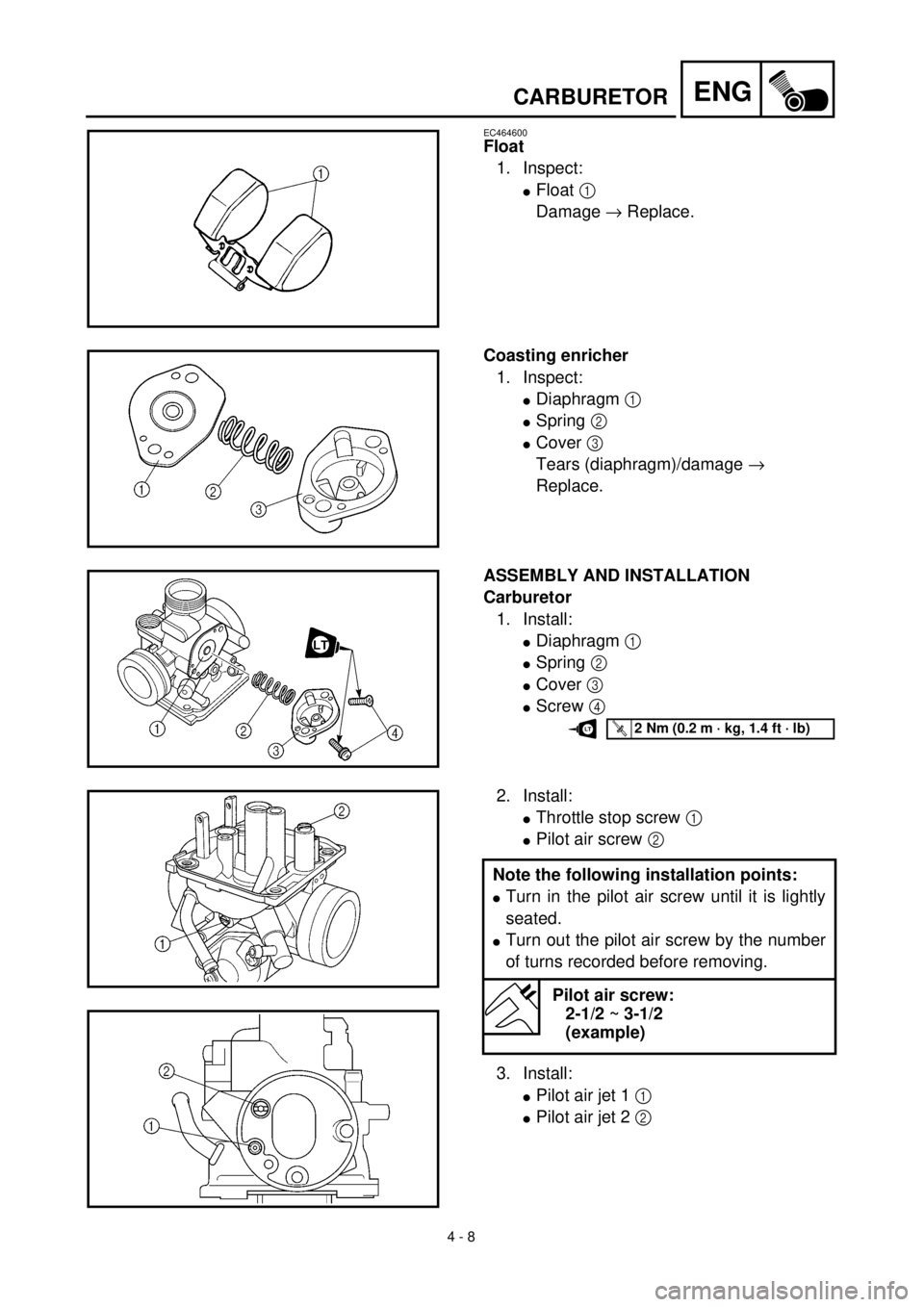
4 - 8
ENGCARBURETOR
EC464600
Float
1. Inspect:
lFloat 1
Damage ® Replace.
Coasting enricher
1. Inspect:
lDiaphragm 1
lSpring 2
lCover 3
Tears (diaphragm)/damage ®
Replace.
ASSEMBLY AND INSTALLATION
Carburetor
1. Install:
lDiaphragm 1
lSpring 2
lCover 3
lScrew 4
T R..2 Nm (0.2 m · kg, 1.4 ft · lb)LT
2. Install:
lThrottle stop screw 1
lPilot air screw 2
3. Install:
lPilot air jet 1 1
lPilot air jet 2 2 Note the following installation points:
lTurn in the pilot air screw until it is lightly
seated.
lTurn out the pilot air screw by the number
of turns recorded before removing.
Pilot air screw:
2-1/2 ~ 3-1/2
(example)
Page 244 of 509

4 - 18
ENGCYLINDER HEAD
5. Install:
lTiming chain tensioner
6. Turn:
lCrankshaft
Counterclockwise several turns
7. Check:
lRotor “I” mark
Align with the crankcase stationary
pointer.
lCamshaft match mark
Align with the cylinder head stationary
pointer.
Out of alignment ® Adjust. Installation steps:
lWhile pressing the tensioner rod lightly
with fingers, use a thin screwdriver and
wind the tensioner rod up fully clockwise.
lWith the rod fully wound, install the gasket
1 and the chain tensioner 2, and tighten
the bolts 3 to the specified torque.
T R..
Bolt (chain tensioner):
10 Nm (1.0 m • kg, 7.2 ft • lb)
lRelease the screwdriver, check the ten-
sioner rod to come out and tighten the
gasket 4 and the cap bolt 5 to the speci-
fied torque.
T R..
Cap bolt (timing chain tensioner):
8 Nm (0.8 m • kg, 5.8 ft • lb)
8. Tighten:
lBolt 1
NOTE:
Tighten the bolt while holding the rotor nut with
a wrench.
T R..20 Nm (2.0 m · kg, 14 ft · lb)
Page 266 of 509

4 - 29
ENGVALVES AND VALVE SPRINGS
lInstall the valve into the cylinder head.
lTurn the valve until the valve face and
valve seat are evenly polished, then clean
off all of the compound.
NOTE:
For best lapping results, lightly tap the valve
seat while rotating the valve back and forth
between your hands.
lApply a fine lapping compound to the
valve face and repeat the above steps.
NOTE:
After every lapping operation be sure to
clean off all of the compound from the valve
face and valve seat.
lApply Mechanic’s blueing dye (Dykem) to
the valve face.
lInstall the valve into the cylinder head.
lPress the valve through the valve guide
and onto the valve seat to make a clear
pattern.
lMeasure the valve seat width again. If the
valve seat width is out of specification,
reface and re-lap the valve seat.
Valve spring
1. Measure:
lValve spring free length a
Out of specification ® Replace.
Free length (valve spring):
Intake:
32.55 mm (1.28 in)
Exhaust:
32.55 mm (1.28 in)
Page 270 of 509
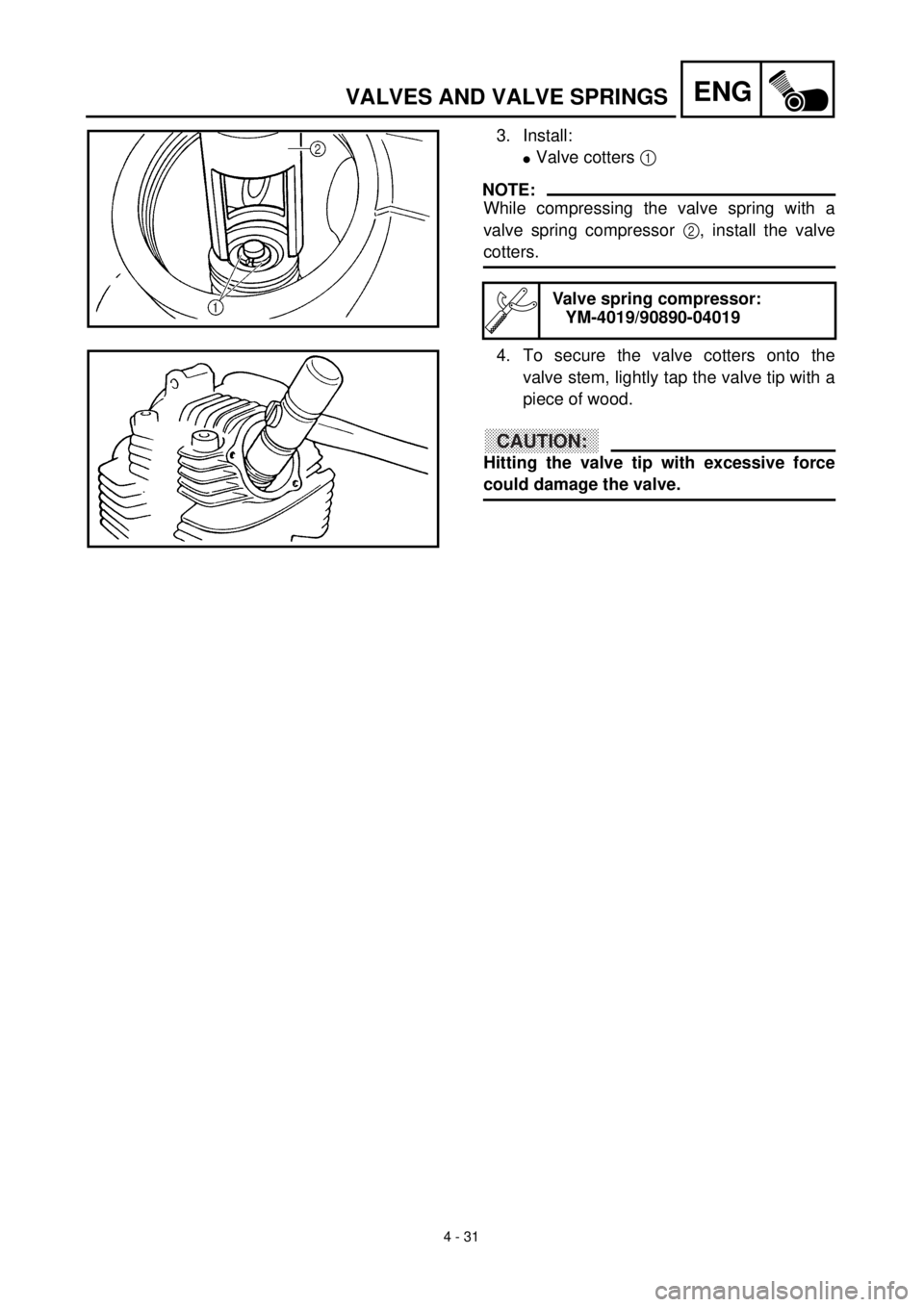
4 - 31
ENGVALVES AND VALVE SPRINGS
3. Install:
lValve cotters 1
NOTE:
While compressing the valve spring with a
valve spring compressor 2, install the valve
cotters.
Valve spring compressor:
YM-4019/90890-04019
4. To secure the valve cotters onto the
valve stem, lightly tap the valve tip with a
piece of wood.
CAUTION:
Hitting the valve tip with excessive force
could damage the valve.
Page 342 of 509

4 - 67
ENGCRANKCASE, CRANKSHAFT AND BALANCER
REMOVAL POINTS
Crankcase
1. Remove:
lBolt (crankcase)
lLead guide 1
lClutch cable holder 2
NOTE:
Loosen each bolt 1/4 of a turn at a time and
after all the bolts are loosened, remove them.
2. Remove:
lRight crankcase 1
Use the crankcase separating tool 2.
NOTE:
lFully tighten the tool holding bolts, but make
sure the tool body is parallel with the case. If
necessary, one screw may be backed out
slightly to level tool body.
lAs pressure is applied, alternately tap on the
front engine mounting boss and transmission
shafts.
CAUTION:
Use soft hammer to tap on the case half.
Tap only on reinforced portions of case. Do
not tap on gasket mating surface. Work
slowly and carefully. Make sure the case
halves separate evenly. If one end “hangs
up”, take pressure off the push screw, re-
align, and start over. If the cases do not
separate, check for a remaining case screw
or fitting. Do not force.
Crankcase separating tool:
YU-1135-A/90890-01135
Page 350 of 509

4 - 71
ENGCRANKCASE, CRANKSHAFT AND BALANCER
2. Install:
lBalancer
NOTE:
Align the punched mark a on the balancer
drive gear with the punched mark b on the
balancer driven gear.
Crankcase
1. Apply:
lSealant
On the right crankcase 1.
NOTE:
Clean the contacting surface of crankcase (left
and right) before applying the sealant.
Quick gasket®:
ACC-QUICK-GS-KT
YAMAHA Bond No.1215:
90890-85505
2. Install:
lDowel pin 1
lRight crankcase
On left crankcase.
NOTE:
lFit the right crankcase onto the left crank-
case. Tap lightly on the case with soft ham-
mer.
lWhen installing the crankcase, the connect-
ing rod should be positioned at TDC (top
dead center).
Page 356 of 509
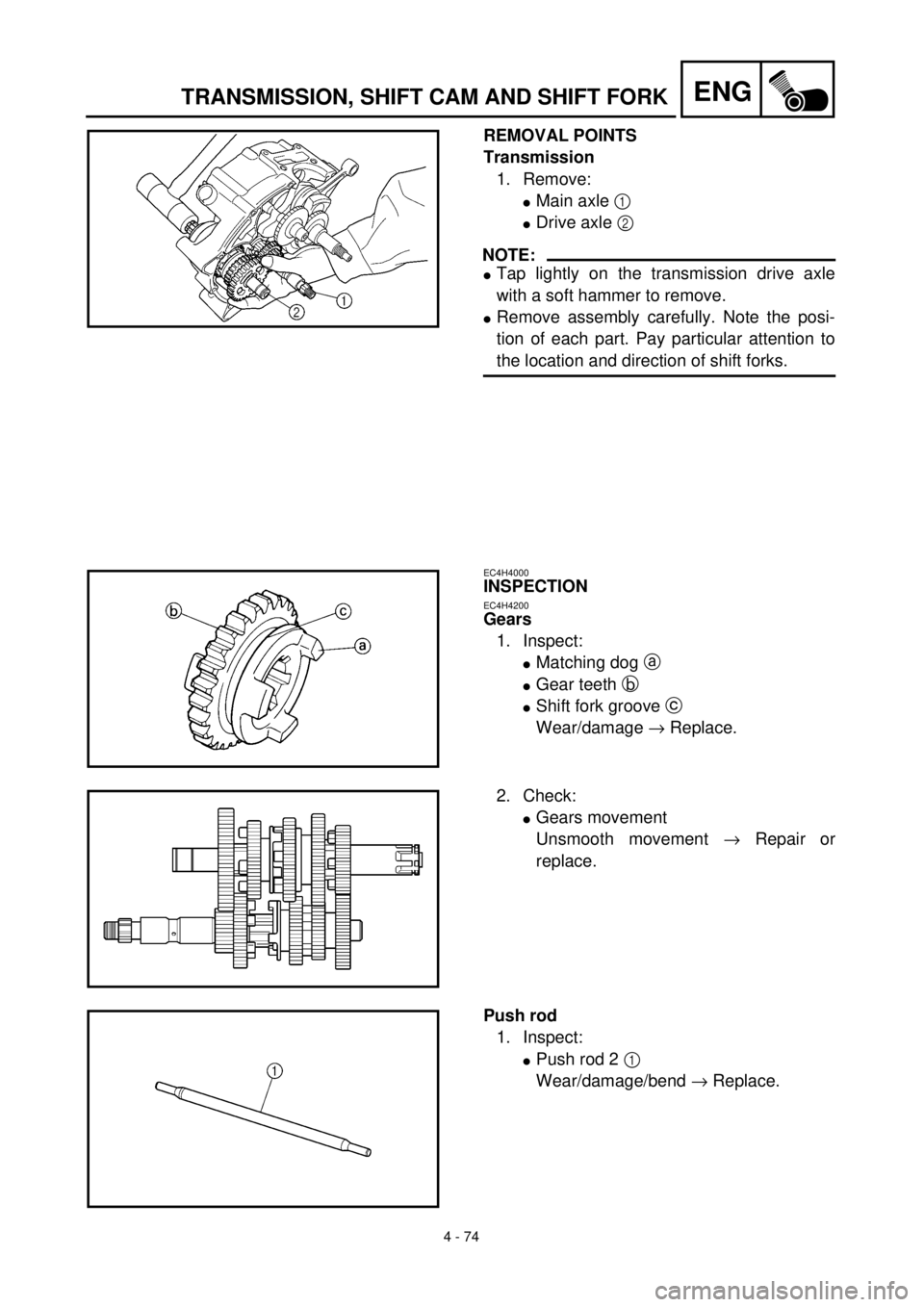
4 - 74
ENGTRANSMISSION, SHIFT CAM AND SHIFT FORK
REMOVAL POINTS
Transmission
1. Remove:
lMain axle 1
lDrive axle 2
NOTE:
lTap lightly on the transmission drive axle
with a soft hammer to remove.
lRemove assembly carefully. Note the posi-
tion of each part. Pay particular attention to
the location and direction of shift forks.
EC4H4000
INSPECTION
EC4H4200
Gears
1. Inspect:
lMatching dog a
lGear teeth b
lShift fork groove c
Wear/damage ® Replace.
2. Check:
lGears movement
Unsmooth movement ® Repair or
replace.
Push rod
1. Inspect:
lPush rod 2 1
Wear/damage/bend ® Replace.
Page 372 of 509
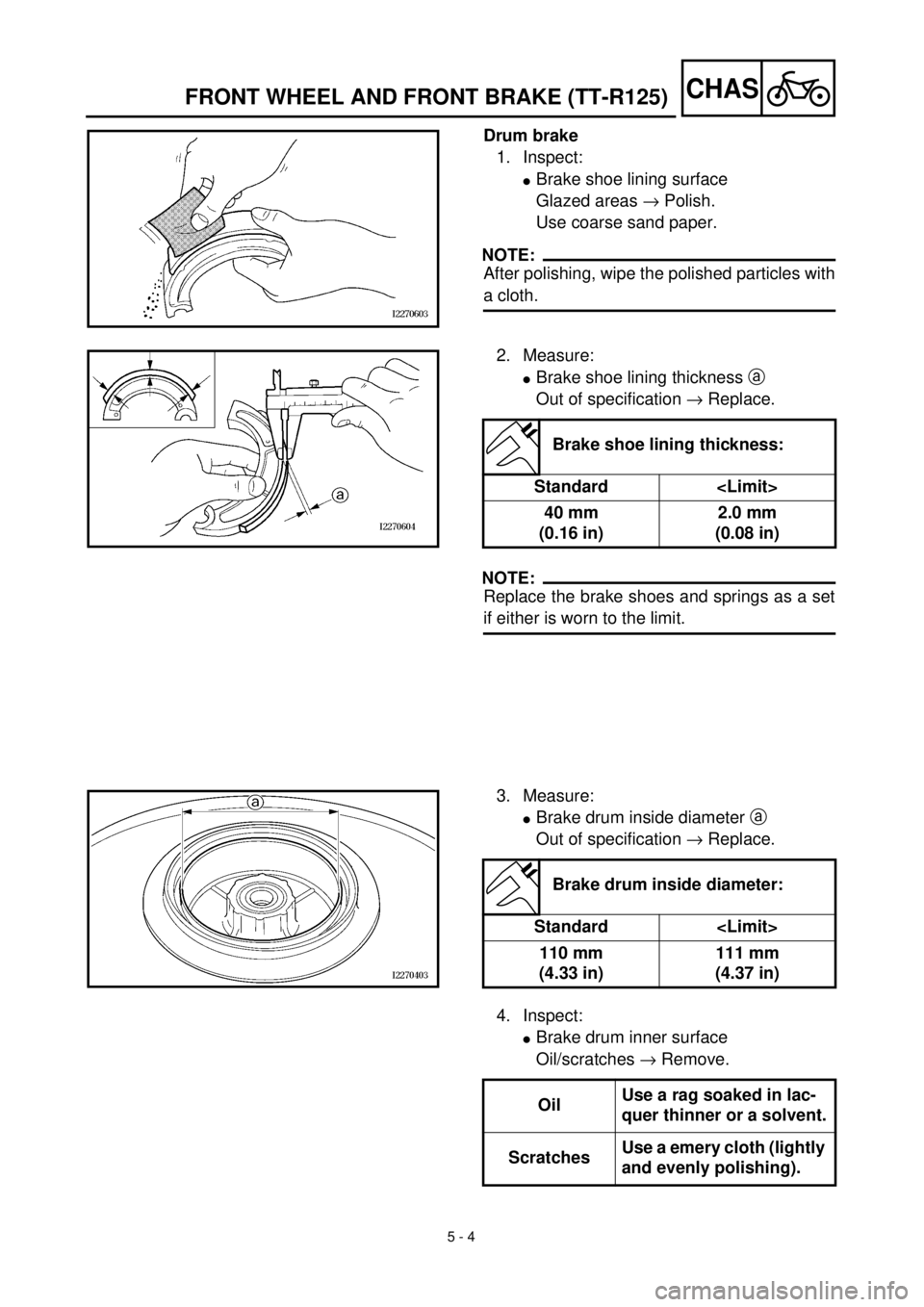
5 - 4
CHAS
FRONT WHEEL AND FRONT BRAKE (TT-R125)
Drum brake
1. Inspect:
l
Brake shoe lining surface
Glazed areas
®
Polish.
Use coarse sand paper.
NOTE:
After polishing, wipe the polished particles with
a cloth.
2. Measure:
l
Brake shoe lining thickness
a
Out of specification
®
Replace.
NOTE:
Replace the brake shoes and springs as a set
if either is worn to the limit.
Brake shoe lining thickness:
Standard
40 mm
(0.16 in)2.0 mm
(0.08 in)
3. Measure:
l
Brake drum inside diameter
a
Out of specification
®
Replace.
Brake drum inside diameter:
Standard
110 mm
(4.33 in)111 mm
(4.37 in)
4. Inspect:
l
Brake drum inner surface
Oil/scratches
®
Remove.
OilUse a rag soaked in lac-
quer thinner or a solvent.
ScratchesUse a emery cloth (lightly
and evenly polishing).
Page 404 of 509
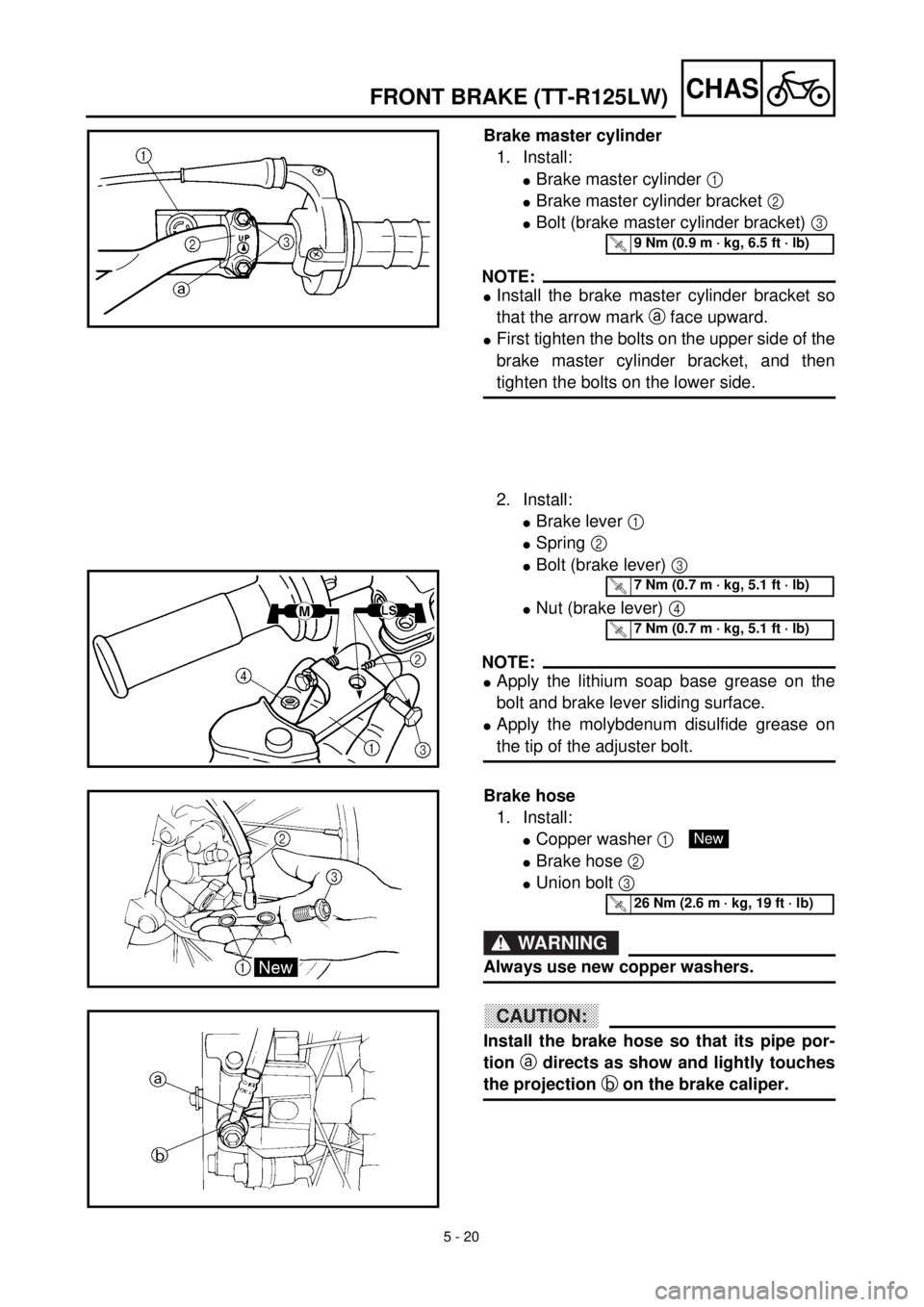
5 - 20
CHAS
Brake master cylinder
1. Install:
lBrake master cylinder 1
lBrake master cylinder bracket 2
lBolt (brake master cylinder bracket) 3
NOTE:
lInstall the brake master cylinder bracket so
that the arrow mark a face upward.
lFirst tighten the bolts on the upper side of the
brake master cylinder bracket, and then
tighten the bolts on the lower side.
2. Install:
lBrake lever 1
lSpring 2
lBolt (brake lever) 3
lNut (brake lever) 4
NOTE:
lApply the lithium soap base grease on the
bolt and brake lever sliding surface.
lApply the molybdenum disulfide grease on
the tip of the adjuster bolt.
T R..9 Nm (0.9 m · kg, 6.5 ft · lb)
T R..7 Nm (0.7 m · kg, 5.1 ft · lb)
T R..7 Nm (0.7 m · kg, 5.1 ft · lb)
Brake hose
1. Install:
lCopper washer 1
lBrake hose 2
lUnion bolt 3
WARNING
Always use new copper washers.
CAUTION:
Install the brake hose so that its pipe por-
tion a directs as show and lightly touches
the projection b on the brake caliper.
New
T R..26 Nm (2.6 m · kg, 19 ft · lb)
FRONT BRAKE (TT-R125LW)